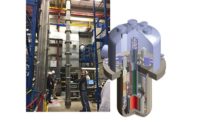While questions swirl around the future of large nuclear plants in the U.S., NuScale, majority owned by Fluor, is pushing a plan to build a nuclear plant using its small, 50-megawatt modular reactors.
On March 15, the Nuclear Regulatory Committee announced it would review NuScale’s application for its small modular reactor. The NRC is expected to take about 40 months to review the 12,000-page application.
Later this year, regional wholesale power supplier Utah Associated Municipal Power Systems is expected to file with the NRC for a license to build and operate a 600-MW plant using 12 NuScale reactors at the Idaho National Lab. If certified, the plant could be built within 36 months and producing power by 2026, says Tom Mundy, chief commercial officer for NuScale.
Mundy says the “modular” reactor vessels will be built remotely and then shipped to the site. Concurrently, sitework, which Mundy calls a “fairly straightforward, large civil concrete project,” would be proceeding. Mundy says the biggest market for plants is in the replacement of retiring coal plants, but nukes would face competition from natural-gas power plants, which can be built at lower cost.
The small demand for and obstacles standing in the way of nuclear power caused BWXT and Bechtel on March to announce they are no longer actively pursuing their small modular reactor concept, called mPower.
But the same month, Urenco and GE Hitachi Nuclear Energy separately announced they are developing their own small nuclear reactors. Currently, there are under development about 45 small reactors, each with a design output of 300 MW or less.
Mark Nichol of the Nuclear Energy Institute, a trade group, says the changes are a “natural dynamic in the market.” NEI is confident that the SMR market will start to gain traction in about 2020.




Post a comment to this article
Report Abusive Comment